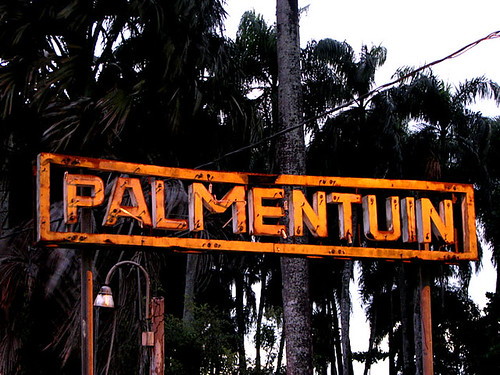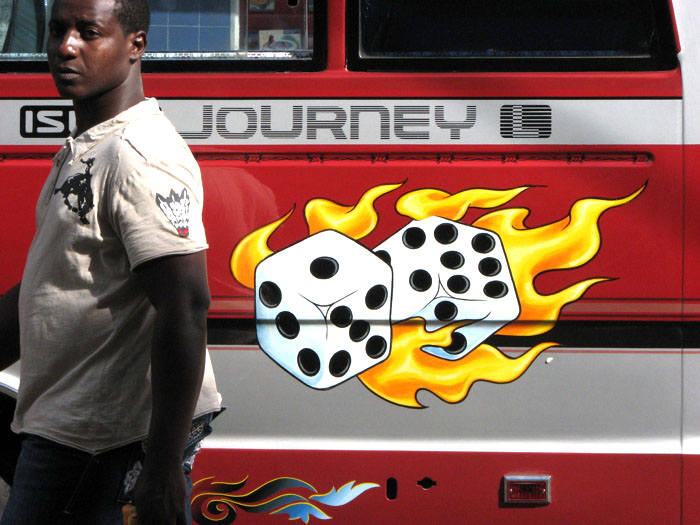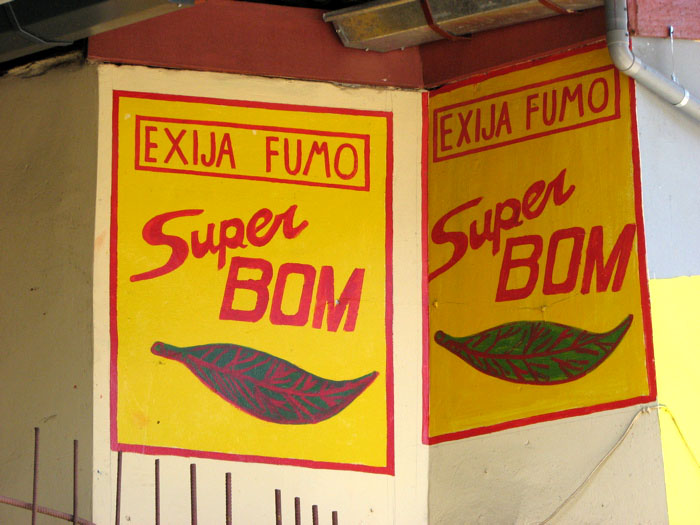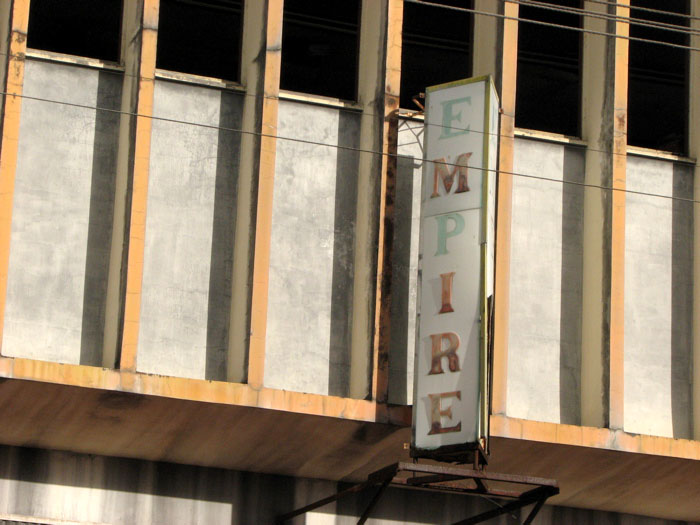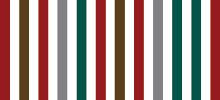The Paramaribo SPAN blog will take a short hiatus in December and early January, as our team prepares for the opening of the SPAN exhibition in Paramaribo on 26 February, 2010.
Readers on Facebook, feel free to join the Paramaribo SPAN group here, and look out for more information about events on the opening weekend.
A short break
Tuesday, December 1, 2009
Notes: seamless spaces
Thursday, November 26, 2009
By Christopher Cozier
Billboard advertising a Kevin Lyttle concert, Paramaribo, October 2009; photo by Christopher Cozier
While photographing a Kassav concert poster in Paramaribo, I noticed a bird cage hanging nearby. The owner informed me that his bird could sing anything, even Kassav, if I wanted to hear. This was the same kind of seed bird one finds in Trinidad in similar cages — birds that are walked and sunned obsessively by their keepers — birds for whom music is often played to motivate them to trill, or “shine”, as we say in Trinidad.
I began to wonder if the ones at home could sing David Rudder, Jah Cure, or Kassav. Many of these birds fly over to Trinidad from the continent and, sadly, are sometimes brought over by smugglers. I wonder what tunes they carry in their heads if they have been moved from one forest, urban space, or state of captivation to another?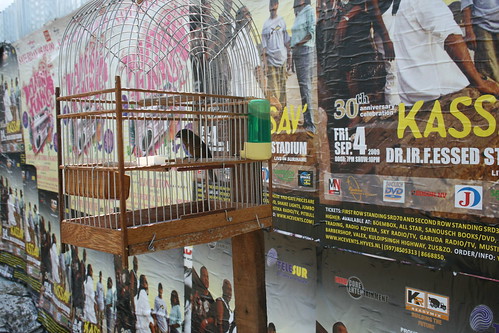
Caged songbird and Kassav poster, Paramaribo, October 2009; photo by Christopher Cozier
This was on my mind walking through the streets of Amsterdam a couple of months later, when I came upon a poster for a reggae event. There is a way that Caribbean music or musical interests create a seamlessness between locations. The dance-floor, the beat, is always there; wherever the people settle and or pass through, from island to island, from islands to continents.
This sense of a presence is always there ... this visibility or audibility often defines the world in which we find ourselves, whether in concert halls, from car stereos and radio stations, or inside our iPod in the subway, tube, or tram. The playbills, the posters map out this transnational dancehall. This heartbeat, as Africa and India become processed or process their influences, seems to be everywhere now. How is contemporary visual practice to be understood through its dialogues and contexts in comparison?
Vybz Kartel was just in Trinidad, while in Suriname I saw posters for Kassav, and friends were flying over to Curaçao to catch a performance of Juan Luis Guerra. The electronic voice from the GPS system giving directions in a car in London was programmed to have a London-Jamaican accent!
A thumping car passes outside as I make this note ... if I close my eyes, where could I be within this moment?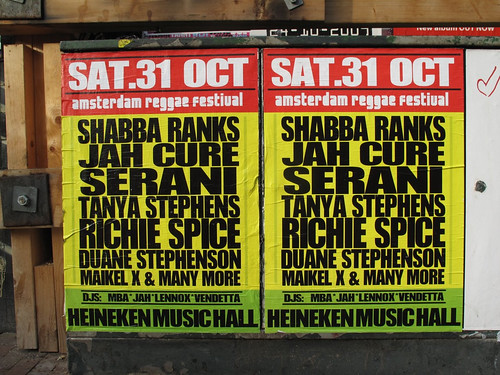
Posters for a reggae concert, Amsterdam, November 2009; photo by Thomas Meijer zu Schlochtern
Diary: Daniel Djojoatmo's Republiek
Monday, November 16, 2009
By Christopher Cozier
27 June, 2009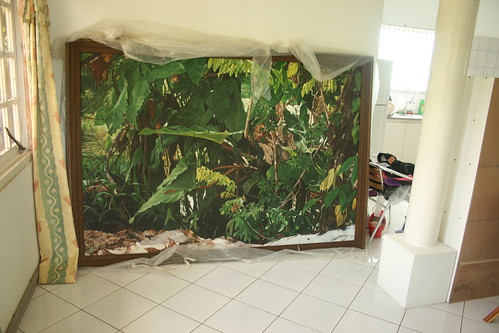
Republiek (2009, oil on canvas), by Daniel Djojoatmo, in the artist's studio. Photo by Christopher Cozier
Visiting Daniel Djojoatmo at his house in Commewijne, east of Paramaribo, I was at first drawn to his watercolurs of decaying cars, the detritus of modernity, trade routes, and “foreign used” vehicles, dumped all over the Caribbean from Japan, now being absorbed by the jungle. The images of these vehicles rusting and being enveloped by vines discuss the predicament of certain narratives of development which are, at their inception, ill-fated and at the disposal of the jungle.
Then in Danny’s studio I saw a large, obsessively constructed photo-realist painting called Republiek. It was a very grand and meticulous rendering of an obscure little section of tropical forest floor, looking almost like a botanical sample. The connection between the grand-sounding title and scale and the obscure perhaps personal moment said something about the shifted and shifting subject.
Republiek, I discovered, is a popular weekend and holiday location south of Paramaribo, a place for a family outing or for dating couples. But in this painting the sight, or accepted or familiar view or scene, is not obviously illustrated in the way we are accustomed to from the era of topographical nationalist and or touristic rendering. We are left to wonder what kind of sly commentary is at hand, or adjusted sense of value of the location.
Because of the over-commodification and overloaded symbolic register of the local landscape, Danny is involved in rethinking from a personal level his interests and relationship to place. By zooming into fragments of the landscape, he makes them unfamiliar, and interrogates the idea of public space.
Labels: commewijne, cozier, daniel djojoatmo, diary, painting, republiek
Elsewhere: November 2009 issue of De Surinoemer
Friday, November 13, 2009

The November 2009 issue of De Surinoemer has been released online. It features interviews with artist Roberto Tjon A Meeuw and theatre practitioner Alida Neslo, a poem by Karin Lachmising, and Dutch artist Risk Hazekamp's Let Them Talk.
De Surinoemer is a free journal published at irregular intervals, documenting the ArtRoPa project. It is distributed in Paramaribo in a limited-edition printed version, and online in various formats (text, PDF, JPEG) at www.desurinoemer.net.
Notes: Rahied Abdoel’s gearsticks
Monday, November 9, 2009
Excerpts from notes by artist Ellen Ligteringen on the 2009 National Art Fair in Paramaribo
7 November, 2009
Wooden gearsticks by Rahied Abdoel, installed at the 2009 Suriname National Art Fair; photo by Ellen Ligteringen
The young artist Rahied Abdoel is participating in the National Art Fair of Suriname for the first time this year. His work is in the first area I visit in the exhibition hall. In a split second, the piece on the right-hand side, an arrangements of wooden gearsticks, takes my full attention and it stays there for a while.
The piece does not tell exactly what it is. It could be a display of functional handmade objects, or a nice poem about movement, but it could also be an altar for all the victims of traffic accidents in Suriname, more than two deaths a week lately. Or is it a display of objects to show off the status symbol of a car? Or is it just functional? The piece refuses to be an explanation of a single thought.
Wood carvings and other works by Rahied Abdoel; photo by Ellen Ligteringen
The artist is standing next to me as I talk to myself, obviously a little too loudly. So he introduces himself. He is self-taught. In the art fair catalogue, Rahied is listed as a painter. His work is installed in the painting section of the exhibition hall. I ask him why. He tells me his work started with charcoal drawings. This year he started to make wooden pieces. He draws with wood and on wood, making sculptures, clocks, wall pieces with text, walking sticks, and gearsticks. Every work is well-polished and covered with a layer of two-component varnish. For Rahied, it is even important that the back side of a two-dimensional wooden wall piece is polished well too, even though no one may see it.
He says he develops an idea for a work in close harmony with his parents and younger brother. You could say the process is almost democratic. The religious background of the family plays a key role in what he makes. Most of the work refers to the Koran, to his Islamic faith. His favorite three-dimensional piece is an assemblage of prayers in wood, presenting a man who confesses his faith.
I ask him about the gearsticks. This was his idea. He knows about handmade wooden gear sticks for the luxury cars. Outside Suriname this is a very niche product. He displays them together with his walking sticks for aesthetic reasons, and he prefers to show his wooden objects on a red surface.
Rahied Abdoel; photo by Ellen Ligteringen
I ask him what kind of work he plans to make next, after the art fair. Rahied says he wants to show his personal environment in a different way, or to transform his environment.
I’m very touched by the display.
Labels: carving, ligteringen, notes, rahied abdoel, sculpture, wood
Conjunction: street posters/Ravi Rajcoomar
Monday, October 26, 2009
By Nicholas Laughlin
Battle of Hispagnola posters along Kleine Waterstraat, Paramaribo, 28 June, 2009; photo by Nicholas Laughlin
An urban landscape is defined not only by buildings and squares and streets, but also by the people who inhabit and pass through them, their vehicles and equipment and merchandise, and the ephemeral traces they leave behind in the form of signs, graffiti, and posters.
Walking around Paramaribo, I noticed there were specific locations — the walls of abandoned buildings, temporary fences and hoardings — where event promoters advertise their parties, concerts, or sports tournaments, sticking up posters in overlapping dozens or even scores to achieve maximum visibility. In late June 2009, three events dominated this urban wallpaper: a "Battle of Hispagnola" boxing tournament, pitting Surinamese fighters against a team from the Dominican Republic; a concert by the visiting Congolese performer Djouna "Big One" Mumbafu; and the Lustig Festival, a big party organised by private promoters at a river beach inland from Paramaribo.
Djouna Big One and Lustig Festival posters along the Waterkant, Paramaribo, 24 June, 2009; photo by Nicholas Laughlin
Of the three, the Lustig Festival posters were the most arrestingly surreal. They emphasised the white sand of the beach location, and the event's tagline — "A Caribbean Fusion of Fantasies" — achieved visual form in a montage of stock photos. A flamingo, an alligator, three pots of gold, a monkey, colourful tree frogs, a bottle of Champagne, a toucan, and a young woman with Latin features — wearing a tiny bikini — burst forth from a pirate's treasure chest. You could write a whole dissertation on what this assemblage of images in this context says about Suriname's relationship to the Caribbean, or to ideas of "Caribbeanness".
Behind the Mask (mixed media, 120 x 145 cm, 2008) by Ravi Rajcoomar; image courtesy the artist
Ravi Rajcoomar's recent paintings, with their bold colours, graphic deployment of text, stencilled silhouettes, and palimpsestic collages, make explicit reference to street posters, graffiti, and the accidental, evolving "murals" created by layers of paint, paper, and glue on Paramaribo's urban surfaces. Their mirror-reversed text fragments and ambiguously gesturing human figures suggest stymied communication: a dream diary, a narrative without a key, a map missing its legend. He writes that these works explore "the mystery, the unknown, the untold, the unspoken, and the unsaid" of human interaction.
More immediately and subtly than a traditional topographical view — a rendering of a picturesque building or bustling market scene — Rajcoomar's paintings record the city of Paramaribo, close up and at street level. Words depicted as graphic forms overlap like voices from a crowd. Chaos plays against order, energy against melancholy, as in urban landscapes anywhere in the world, but letterforms hinting at Afaka script ground these works in Suriname, in Paramaribo.
Rajcoomar at work in his studio during his recent residency in Rotterdam; image courtesy the artist
See more of Rajcoomar's recent works at his website.
Labels: afaka, conjunction, graffiti, painting, poem, rajcoomar, street painting
Project: Dhiradj Ramsamoedj, Adji Gilas
Sunday, October 18, 2009
By Christopher Cozier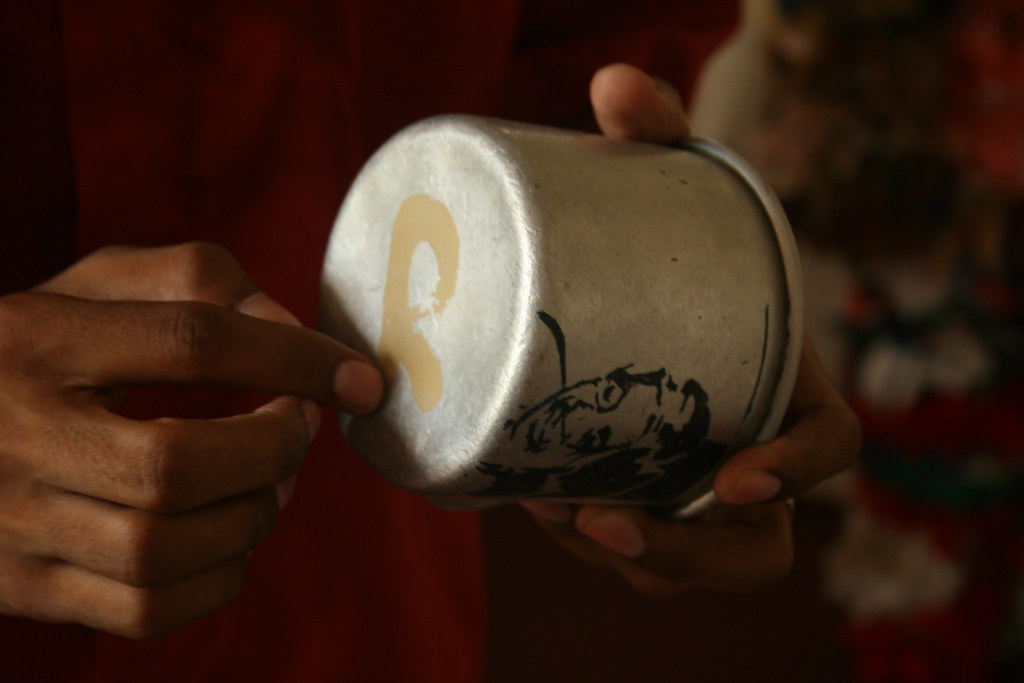
Dhiradj Ramsamoedj holding one of his Adji Gilas cups
September 2009
A few examples of Dhiradj Ramsamoedj’s Adji Gilas cups are placed on the red-oxide-coloured floor of his studio. This is a typical painted floor for a house in Kwatta, west of central Paramaribo, and this looks like a typical cup. We could be in Trinidad or Guyana. He is explaining to me that “adji” means maternal grandmother, and that these aluminium mugs were from her once-active business renting wares for festivities and other events.
Dhiradj points out that the cups still have an “R” written in enamel paint underneath. There are approximately forty of them left. The artist has transferred onto them graphic images derived from early photographs of his grandmother. So this is not just a typical house, or a typical cup: it is Dhiradj’s. We are looking at this work in his grandparents’ home, which has now become his studio or site of investigation. This is a very personal navigation of his experience — his own memory and relationship to family and place.
We are on the inside of his process, and this location is not just a sight to be rendered — not just an image to take to the market, as we see in local art galleries throughout the Caribbean. Most forms of representation in the Caribbean would render the house and the location from a viewpoint across the street, for the touristic or cultural brochures, saying that this is the typical Asian household of this part of the country. It would be a static silenced sign of national diversity or of cultural otherness, accordingly.
But this is Dhiradj’s active site of investigation, of developing personal vocabularies towards sovereign ways of articulating his own lived experiences and stories, from the inside looking out.
I ask him if the work should even leave this site, as the work, the process of minding (caring for) and mining (investigating the symbolic agency of) these intimate elements, this series of actions, resonate within this actual space. They transform the space, which both contains and amplifies their intent. They take on a site-specific implication, and the artist’s actions become differently performative and enabling — not just to me, the viewer, but also to other artists like himself working in places like this everywhere. This is more than just cultural display. This about the artist working his way through what he knows and can understand.
I would like to argue that within this transactional space or moment of exchange we are all transported or altered. So where is Kwatta now within this moment?
Is it in the critical space shaped by his intent, his investigative process, dislodged from narratives of nation, of culture, of cultural display and otherness? Is it an action within the critical space we call the Caribbean, which is just another space where an artist, a creative individual, struggles to understand the world around him- or herself?
After I meet with Dhiradj, he sends me an image by email, in which he arranges the cups — “gilas” — on the internal structural beams of the wooden house, often used as shelves in traditional Caribbean homes. In that single gesture, he weaves together the structural investigations of Remy Jungerman with, of course, Mondrian’s. They are all fair game within his investigative moment.
It is not my intention to create an imbalance, but more to look at the work of Dhiradj as someone whose approach is derived from the current range of influences available to him. This processing and reconfiguring defines the current moment in which many contemporary Surinamese artists are proceeding.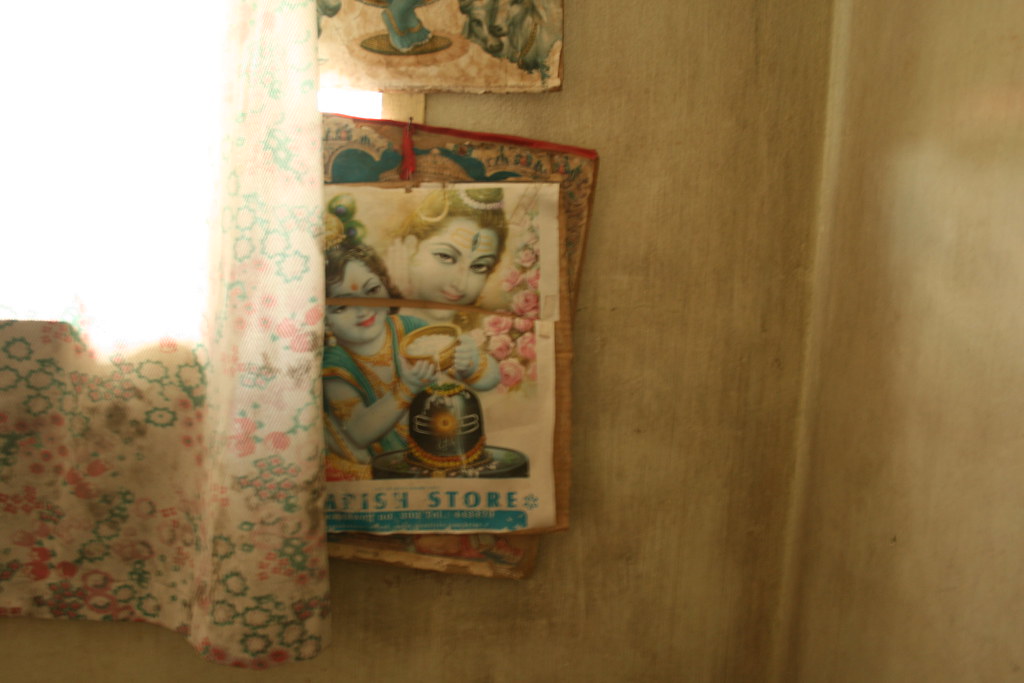
Hindu devotional images in Ramsamoedj's house
Dhiradj Ramsamoedj graduated from the Nola Hatterman Institute in Paramaribo in 2004. His most recent exhibition was Double Feature, together with Kurt Nahar, at the Readytex Art Gallery in August 2009.
Labels: cozier, jungerman, kwatta, project, ramsamoedj
Seen: param@ribo, by Maartje Jaquet
Tuesday, October 13, 2009

Maartje Jaquet is a video artist, photographer, and graphic designer based in Amsterdam. She writes:
My art is about seeing the wonder of daily life in simple things that other people may overlook. It's simple-with-a-twist. I like to share the poetry, wonder and humour of life, being strange enough as it is in itself.
In January 2009, Jaquet visited Suriname to lead a series of oneminute video workshops at AHKCO in collaboration with the Nola Hatterman Art Academy. She documented her time there in a series of photos and videos posted in a Flickr set titled param@ribo.
These still and moving images suggest a fascination with Paramaribo's urban texture: the proliferation of signage, the way people move through public spaces, fragments of buildings or machinery that function almost like pieces of found sculpture.
View Jaquet's Suriname images here.
Labels: maartje jaquet, photography, seen, sign, video
Elsewhere: Sranan Art Xposed
Thursday, October 8, 2009

Paramaribo SPAN contributor Marieke Visser and her collaborators Cassandra Gummels-Relyveld and Priscilla Tosari--supported by the Readytex Art Gallery--have launched a new quarterly e-magazine covering Surinamese art: Sranan Art Xposed. The PDF publication is currently distributed via email, with excerpts posted on the editors' blog. Information on joining the SAX mailing list is available here. The first issue includes a survey of recent art events in Suriname, a short interview with artist Jhunry Udenhout, information on artists' websites, and an article on the recent Wakaman Project.
The editors write: "We seek links, we make connections, we look for news, we spread the news, we zoom in, and we zoom out."
Labels: magazine, sax, sranan art xposed, udenhout, visser
Diary: meeting Pierre Bong A Jan
Thursday, October 1, 2009
By Nicholas Laughlin
26 June, 2009
Paramaribo's northern suburbs are orderly in their sprawl: streets laid out in a careful grid, neighbourhoods separated by drainage canals. The flat terrain with few large landmarks is confusing to visitors--even after several visits to this area I still feel like we're going round in circles--and apparently even taxi drivers can get lost.
Chris and I are fascinated and puzzled by this topography. In most Trinidadian suburbs, you can guess when the land was developed by the predominant architectural style of the houses, which subsequent renovations and remodellings can't completely disguise. But here there is a sense of the temporally haphazard. On a single street we see an old wooden house on stilts--what Chris calls a Guyana house--that could date back to the 1930s or 40s, right next to a 70s bungalow and a spanking new mini-mansion, then an empty lot overgrown with razor grass that to our sensibilities suggests "country".
After several wrong turns on the part of the taxi driver, we finally arrive at Pierre Bong A Jan's house, one of the new-looking ones, facing south onto a broad canal. Bong A Jan waves to us from an upper window, then comes down to escort us past a phalanx of excited big dogs. He is one of the younger artists we've met in Paramaribo, quiet and confident, with a scraggly beard, a necklace of wooden beads, and a series of blue-black tattoos on his left shoulder and upper arm.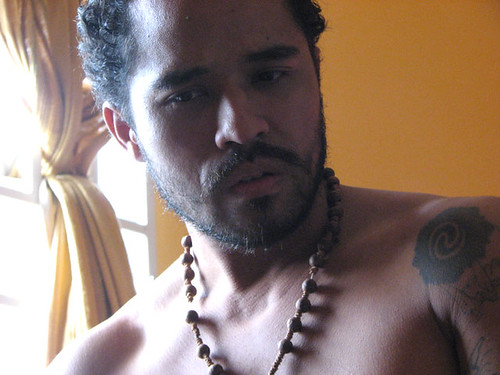
Pierre Bong A Jan in his tattoo studio. Photo by Nicholas Laughlin
The house is neat, airy, tastefully furnished. A large canvas, perhaps six feet wide, is propped against the wall of the front hallway. It depicts a monstrous semi-human creature pouncing on a nubile young woman. The creature's shoulder emerges from the canvas as a piece of wood carving. It makes me think simultaneously of comic book illustration and a stylised Erté poster. The painting is one of a series, Bong A Jan explains, exploring a figure from Surinamese folklore: the bakru, a half-flesh, half-wood forest spirit which does the bidding of its obeahman master.
Bong A Jan takes us up a flight of stairs to a spacious, light-filled loft that runs the full length of the house. This is his main studio, with finished paintings arrayed along one side, pots full of paintbrushes, and an airbrush compressor next to a draftsman's table. He shows us another large painting of a nude young woman, floating against a geometrical background. Both her shoulders are covered with tattoo-like markings, which on closer inspection turn out to be clusters of faya lobi, or ixora flowers--the national flower of Suriname. Beside it is a painting of pairs of eyes glowing out of a deep blackness, like a dream of being lost in the bush at night.
Faya Lobi (2008), by Pierre Bong A Jan. Photo by Marieke Visser
His second studio is a much smaller space, tucked beneath the loft. This is where Bong A Jan works at his day-job: he is a tattoo artist. He shows us his equipment, the padded table where clients lie, and the gun-like tattoo machine. I ask him who did the tattoos on his own shoulder. He smiles. He did them himself, he says--that's why they're on one side only.
Chris asks to see some photos of his other tattoo work. Bong A Jan pulls up a slideshow on his laptop. Some of the images depict standard fare: pseudo-Celtic knots and the like. Others incorporate recognisably Surinamese visual elements, some derived from traditional Maroon carving. One spectacular large tattoo seems to combine Botticelli's Venus with a many-armed Hindu goddess. A few years ago, Bong A Jan tells us, most of his clients asked for standard images and forms you could pick out of any pattern book, but recently there's been more interest in imagery that speaks to a Surinamese identity.
We can see how Bong A Jan's work sets up a creative dialogue between these two media, painting and tattoos, at a meeting-point of conventional "fine" art and bodily adornment, folklore and science fiction, international youth culture and personal self-expression. How might we incorporate this dialogue into the wider conversation of Paramaribo SPAN? Bong A Jan wonders aloud whether he could build a temporary structure, part studio, part installation, and find someone willing to be tattooed in front of an audience--the tattoo as a performance, in multiple senses.
"It won't be me," Chris says, laughing.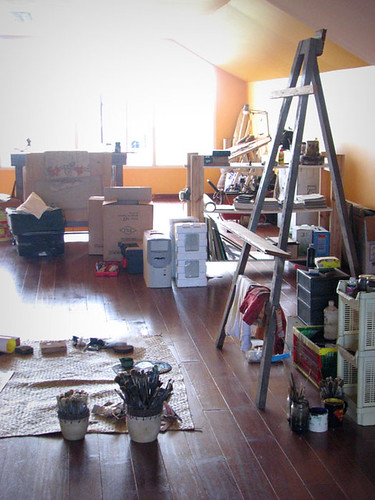
Bong A Jan's painting studio. Photo by Nicholas Laughlin
Labels: bong a jan, diary, folklore, painting, tattoo
Project: Risk Hazekamp, Let Them Talk
Monday, September 28, 2009

Let Them Talk (2009), by Risk Hazekamp
Risk Hazekamp is a Dutch artist based in Rotterdam and Berlin, and one of the participants in the ArtRoPa project. She offers some thoughts on one of the works inspired by her residency in Suriname in 2008.
I use photography to explore issues of identity, and in particular the way in which gender and identity intersect. By evoking and drawing upon mass media and popular visual language — fashion, advertising, and movie genres — I question the construction of (gender) identities.
In this image I place myself in the position of the exotic, the “stared at”, using an eclectic image language that will be read differently depending on the individual luggage of the viewer. At the same time the “stared at” takes back power by staring back at the viewer, and thus also becomes the active one.
For me, this picture contains a lot of personal thoughts and feelings. It functions as an expression of my encounter with Suriname (which is still going on). To highlight a few details/elements:
= Let Them Talk is the name of the specific angisa (headkerchief) in the photograph. [The angisa incorporates a form of visual language: the pattern of knots conveys a specific message, after which each angisa is named.] In Suriname, the angisa is mostly used to express personal feelings, but is it also used as a political tool?
= The angisa in this image is made from newspapers that were published the day after [Dutch politician] Pim Fortuyn was murdered. We can recognise him on the front of the angisa. The bandeau is made of the Surinamese newspaper De Ware Tijd (“The True Time”).
= The picture is a self-portrait, showing me, with my biological female body, dressed as a drag queen: a man performing femininity. It refers to Pim Fortuyn being a very outspoken, flamboyant homosexual individual, which in my opinion contradicts with his extreme, right-wing political points of view.
= The showing of intimate parts of the body is a statement in itself. Not only do I show here the “real” white skin of my body, my breast, against the artificially white skin of my face; in doing so I try to emphasise the fragility, the instability, and the fugacity of the human body.
One of the intellectual frameworks of this work is a book by the social and cultural anthropologist Gloria Wekker: The Politics of Passion: Women's Sexual Culture in the Afro-Surinamese Diaspora (2006). Wekker writes:
In Sranan Tongo ... there is a plethora of terms to make statements about “I”, pointing to the multiplicity and malleability of self....
One of the striking features of this scheme is that it is possible, irrespective of one’s gender, to make statements about self in one of three ways: first, in singular and/or in plural terms; second, in male and/or female terms.... In addition to these different terms, there is a third mode to make statements about self in terms of third-person constructions, i.e., in terms of one’s Winti....
With this photograph I want to express the crux of my work, which is that identity should not be understood as a logical and coherent thing, but as something that is dynamic, fragmented, and a changeable process that is constantly moving.
Labels: artropa, photography, project, risk hazekamp
In Memoriam: Henk Tjon (1948-2009)
Sunday, September 20, 2009
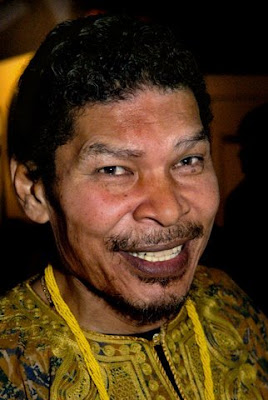
Portrait of Henk Tjon courtesy De Nieuw Amsterdam
Henk Tjon – Suriname's most celebrated theatre director, playwright, and cultural activist – died in Paramaribo on 18 September, at the age of 61. He played a major role in sharing Surinamese culture with the rest of the Caribbean – especially via the Caribbean Festival of Arts, Carifesta, for which he served as Suriname's artistic director seven times over nearly four decades. He was also the co-founder of De Nieuw Amsterdam (DNA) theatre company in the Netherlands.
In 2007, Tjon wrote:
As an active theatre maker in a post-colonial environment, you really have no choice in what kind of theatre you make. You will always want to bring people together with your work, want to stimulate exchange and cohesion between people and their cultures. Naturally, your immediate environment will determine your work to a significant degree, but what all theatre makers who do not work in the West have in common is the fact that they are usually not working for the elite. Whether you are working in India, Uganda, Suriname or Ecuador, theatre is in the middle of society. That is also what gives it a lot of its expressive power.
Personally, the artistic urge has always been my primary drive. But what I hope to achieve with my theatre also applies to those who use theatre as a means to achieve other objectives. We all want to communicate, to touch others, to get people thinking. That will always be the most important function of the theatre. Sadly, all of us former colonies carry an annoying history with us. The fact that others determined how and who we were for us – we have not been liberated from that yet. It will play a large part for a long time.
In the search for identity, theatre has an important function.
Labels: henk tjon, in memoriam, theatre
Meanwhile: September and October 2009
Friday, September 18, 2009
Notes on other current and upcoming art events in Suriname and elsewhere
Entangled Red and Blue (acrylic on canvas, 102 x 82 cm, 1993), by Erwin de Vries. Image courtesy Kunsthal Rotterdam
= Tribute to the Woman: Erwin de Vries
Kunsthal Rotterdam; 12 September to 29 November, 2009
An exhibition celebrating the eightieth birthday of one of Suriname's elder artists. Over 150 paintings, drawings, and sculptures dating from the 1950s to the present offer an overview of de Vries's oeuvre. In December 2009 the show will move to Fort Zeelandia, Paramaribo.
Poster for the Rotterdam exhibition of new work by Ravi Rajcoomar and Roddney Tjon Poen Gie
= Suriname: Ravi Rajcoomar and Roddney Tjon Poen Gie
Centrum Beeldende Kunst, Rotterdam; 19 September to 11 October, 2009
New works produced by two Surinamese artists during their recent ArtRoPa residencies in Rotterdam.
Labels: de vries, meanwhile, rajcoomar, tjon poen gie
Topography: minibus, Maagdenstraat
Tuesday, September 15, 2009
Labels: maagdenstraat, minibus, street painting, topography
Project: Patricia Kaersenhout, Invisible Men
Friday, September 11, 2009

Patricia Kaersenhout is a Surinamese artist based in Amsterdam. She recently participated in the Wakaman Project, which brought Surinamese artists working at home and abroad into a conversation about contemporary art. “As an artist I’m in a constant state of becoming,” she writes, “therefore my work can never be a finished product.... When a work is recognizable, sellable, suitable, please-able it contains too many ‘ables’. For me the only ‘able’ that coincides with my work is dis-able.”
Kaersenhout's most recent project is Invisible Men, a book of images and words inspired by Ralph Ellison's novel of (almost) the same name. Using the pages of an old biology textbook as her staring-point, she “tries to visualize the invisible; from spirit to flesh.”
From writer Eva van Leeuwen's text in Invisible Men:
You are standing really still behind the curtain. You hear people walking by, calling out, doors being opened and closed again. Being invisible seemed like the most wonderful thing imaginable.
Until that one particular day, when you hear nobody walking by and there is no calling out. You must have been standing really still behind the curtain for at least thirty minutes. It slowly dawns on you: there is nobody looking for me. And suddenly it was no longer any fun.
Perhaps you can only be invisible if you are being looked for. If you are not being sought then you simply don’t exist. And what if you are searching for an invisible someone but nobody is searching for you? Who is actually invisible then?
Invisible Men is published in a limited edition by Eindeloos. For more information, or to buy a copy, visit the publishers’ website. See more of the book here.
Labels: book, kaersenhout, project, wakaman
Document: Afaka's first letter
Wednesday, September 9, 2009

ke mi gadu | mi masa | mi bigi na ini a ulotu | fu a papila di yu be gi afaka...
It's estimated there are 25,000 to 30,000 speakers of Djuka (or Ndyuka), one of the Maroon languages of Suriname and French Guiana. Derived from English and several West African languages, Djuka has three distinct spoken dialects as well as a written form, called Afaka script after its creator.
Afaka Atumisi was a Djuka from the Tapanahony region of south-eastern Suriname. Circa 1910 -- inspired, he said, by a dream or vision -- he invented a syllabary of 56 characters which allowed Djuka texts to be recorded and transmitted in writing. Afaka died in 1918, but by 1920 it was reported that over a hundred people in the Tapanahony area could read and write his script.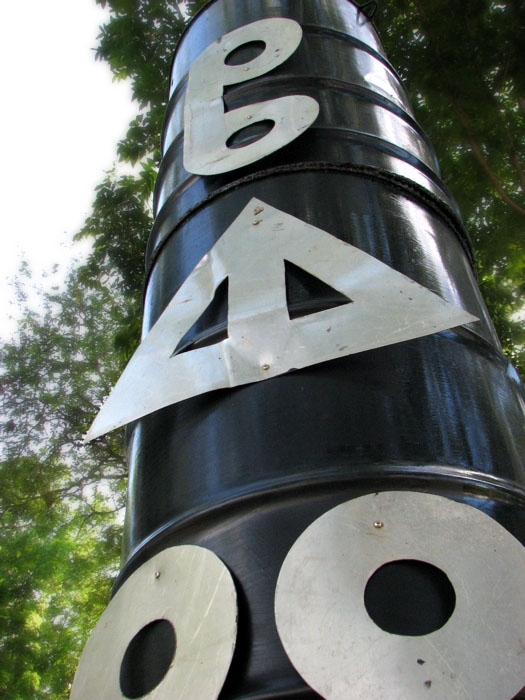
Detail of one of Marcel Pinas's Kibi Wi totems, made from oil drums decorated with aluminium Afaka characters; Fort Zeelandia, Paramaribo, April 2009. Photo by Nicholas Laughlin
In later decades, the number of fluent readers and writers declined -- an article in the Suriname Museum journal in 1975 estimated that "most probably there remain only five." But more recently Afaka script, like other elements of Maroon culture, has been increasingly adopted (and adapted) as a symbol of Surinamese national identity, and the script is not an unfamiliar sight in Paramaribo. Afaka characters are a recurring and assertive motif in the work of Marcel Pinas, a member of the Djuka community in Moengo, but Surinamese artists from other ethnic backgrounds -- including Roddney Tjon Poen Gie and Sri Irodikromo -- also use the script in their exploration of the country's ethnic intricacies.
Air Borne (acrylic on canvas, 67 x 100 cm, 2009), by Roddney Tjon Poen Gie; photo by William Tsang, courtesy Readytex Art Gallery.
"Tjon Poen Gie is well known for using his own visual language, which is based upon the letter symbols of his ancestors," says the Readytex Gallery website." He draws the characters and symbols three-dimensionally and thus produces a playful abstraction of Chinese letters and Afro Surinamese Afaka symbols in his artwork."
The document reproduced at the top of this post is one of the earliest surviving texts written in Afaka script -- a letter by Afaka Atumisi which reports on his unsuccessful trip to the hospital in Paramaribo in search of treatment. Read a full translation here.
Labels: afaka, document, irodikromo, language, pinas, tjon poen gie
Seen: Trefossa, by Ida Does
Saturday, September 5, 2009
Opening sequences from Trefossa: Mi a No Mi (2008), directed by Ida Does
Mi a no mi
solanga mi brudu
fu yu a n'e trubu
na ini den dusun titei fu mi
I am not myself
until my blood
is infused with you
in all of my veins
— From "Gronmama" ("Earthmother"); English translation by Quinton Zondervan
If Suriname has a national poet, Henri Frans de Ziel (1916-1975), who wrote under the pseudonym Trefossa, is perhaps the leading candidate. His groundbreaking 1957 book Trotji, the first published collection of Sranan poems, has been called "the big bang of Surinamese literature." Thousands of Surinamese schoolchildren sing his verse daily — he wrote the Sranan part of the national anthem.
Trefossa: Mi a No Mi (2008), a documentary by filmmakers Ida Does and Paul van den Bos, uses interviews, historic film footage, and Trefossa's own words — from his published poems and unpublished diaries — to tell his story, chart his influence on two generations of Surinamese writers, and investigate how the power of his poems helped legitimise Sranan Tongo in both Suriname and the Netherlands.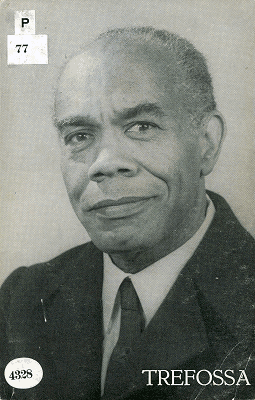
Portrait of Trefossa courtesy the DBNL
The text of Ala Poewema foe Trefossa ("Collected Poems of Trefossa", 1977) is available online at the Digitale Bibliotheek voor de Nederlandse Letteren.
Response: some thoughts on Someni Tongo
Wednesday, September 2, 2009

Part of the audience at the performance of Someni Tongo in the Palmentuin, 29 November, 2008
Just over two weeks ago, Paramaribo SPAN posted information on Dutch artist Arnold Schalks's Someni Tongo project (2008), which examined Suriname's cultural and linguistic diversity through a live performance of a celebrated poem. The comments left on the original post raised interesting questions about how this and other art projects are (or could or should be) received and interpreted by audiences and the wider art community.
Writer Chandra van Binnendijk, who witnessed the live performance of Someni Tongo, offers her personal response to the project and the resulting discussion.
I was one of the handful of people on that early Sunday morning in the Palmentuin nine months ago, there to watch the performance of Someni Tongo. There was a kind of silent conspiracy-like feeling, for being together for the event. The ones with cameras wanted to take pictures, but the best angle near the podium was not approachable: a vagrant had left a fresh turd right in that spot. And the manager of the Palmentuin refused to clean it up, for this was not his duty, he said.
It did not bother us at all: we placed an old newspaper on top of it, we warned others not to step on it, we moved around a little until everyone found his best place around the podium, and then we watched and experienced and enjoyed the Someni Tongo performance. All those tongues, speaking in all those different languages, expressing the same lines -- it was special, it was beautiful, and more so because we were there for the live experience.
The audience that morning left the Palmentuin with a feeling of upliftment, of contentment.
Shouldn't a similar feeling of contentment remain with the one who created this beautiful experience? What happens to the artist when he is so attached to the fruit of his work that he feels disappointed when response and feedback from the public are not what he expects (or even feels he deserved)? When he is not praised or imitated? Where is the pure joy of creating?
I think art is exactly and only about this: the need to create and express what is uniquely inside you, and to do so because you have no choice. Something is envisioned, it wants to come into the world through you, and it can only be born through your effort. Full stop. No ulterior motives. Creation is making art -- not the aftermath.
Someni Tongo was beautiful. But in its significance it was not unprecedented. Over the years, Suriname has seen high-level performances of multi-racial, muli-ethnic, and multi-lingual performances. One example is the theatrical production Rebirth, by director Henk Tjon, which was presented at Carifesta 1981 in Barbados, with a dazzling combination and integration of all these aspects. There have been performances by the National Ballet of Suriname choreographed by Ilse-Marie Hajary, who created the Dogla style, in which she integrated Afro drumming and winti elements with classical Indian dance movements.
So multi-culti is not really new for us. One should not overlook history -- we are able to reach heights because we are standing on the shoulders of those before us. Tjon and Hajary were not greeted with lavish standing ovations -- their work was not understood at first. This takes time.
On that beautiful mormning in the Palmentuin, we did not let the turd disturb us. Because the performance was compelling. The experience was enough.
Art in itself is enough.
Labels: performance, poem, response, schalks, van binnendijk
Topography: outside the main market, Waterkant
Saturday, August 29, 2009
Labels: sign, topography, waterkant
Notes: on bridges and meetings
Wednesday, August 26, 2009
By Christopher Cozier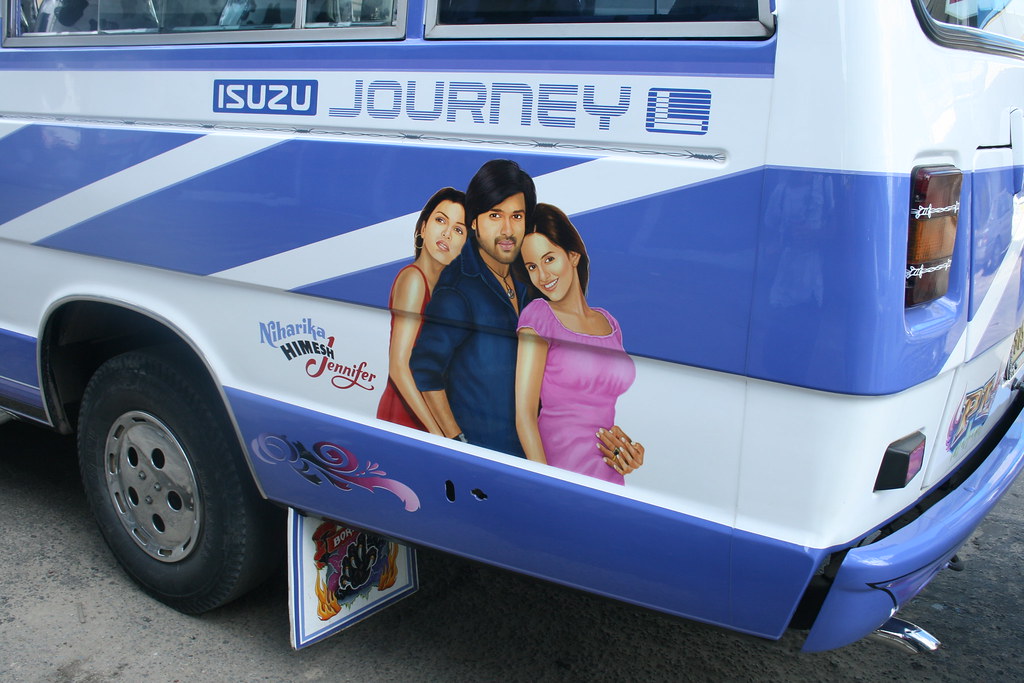
Painting of Bollywood stars on a minibus in downtown Paramaribo, June 2009. Photo by Christopher Cozier
Initially, I was thinking of a theme around bridges, derived from the obvious: the two distinctive bridges, the Jules Wijdenbosch Bridge in Paramaribo and the Erasmus Bridge in Rotterdam. Both registered on my mind from the landscape on my first visits. For both cities, the bridges are significant to their stories and ambitions, reaching across not just water but communities and ways of understanding or experiencing where they are located. To me, this spoke about the role of visual practice and its dialogues--its potential to make connections between artists working in different but related circumstances.
In discussion with Marcel Pinas, Chandra van Binnendijk, Marieke Visser, Thomas Meijer, and Nicholas Laughlin, in what’s left of the iconic bar at the Torarica Hotel, the word “span” came up. Nicholas wanted to know whether, in local languages or Dutch, the word carried any further meanings or usages. I was still processing “ontmoeting”, the title of one of Soeki Irodikromo’s new paintings. It was a gestural work, with his distinctive and adventurous use of colour, which for him expressed a meeting point--an unlikely reckoning of people and ideas, but distinctive of the region. Like “span”, it conveyed the purpose or the idea.
Span is a word common to English, Dutch, and Sranan, via different etymologies, and with a range of meanings, nuances, implications. It is the space between two points, the means of crossing that space, a linking or pairing, a tension, a tightening, an excitement, a fullness, a reaching out.
What we in the Caribbean call Suriname is really Paramaribo, like Georgetown in Guyana: a coastal settlement with what appears to be an unfathomed “interior” and an ocean in front of it--or is it the other way around, with the ocean at its back? These settlements sit between two apparently infinite domains. It is a place between the Amazon and the Caribbean Sea ... a kind of entry point to something--something out-there or in-there that is not fully grasped.
On my first visit to Suriname, as I drove across the Jules Wijdenbosch Bridge, I felt that I was reaching inward and outward simultaneously. Ideas of the Caribbean, heavily shaped by island-ness, begin to diminish. This is the northern edge of a very large continent, and one of the starting points of exploration, conquest, and the ongoing formulation of the otherness of its climate, people, and landscape.
Why and how I see Suriname as a Caribbean place remains an open question. Is it because of the post-colonial, post-plantation dynamics of the transplanted people and architecture, or is it because the passing cars are thumping--reacting and agitating with Bollywood and dancehall beats?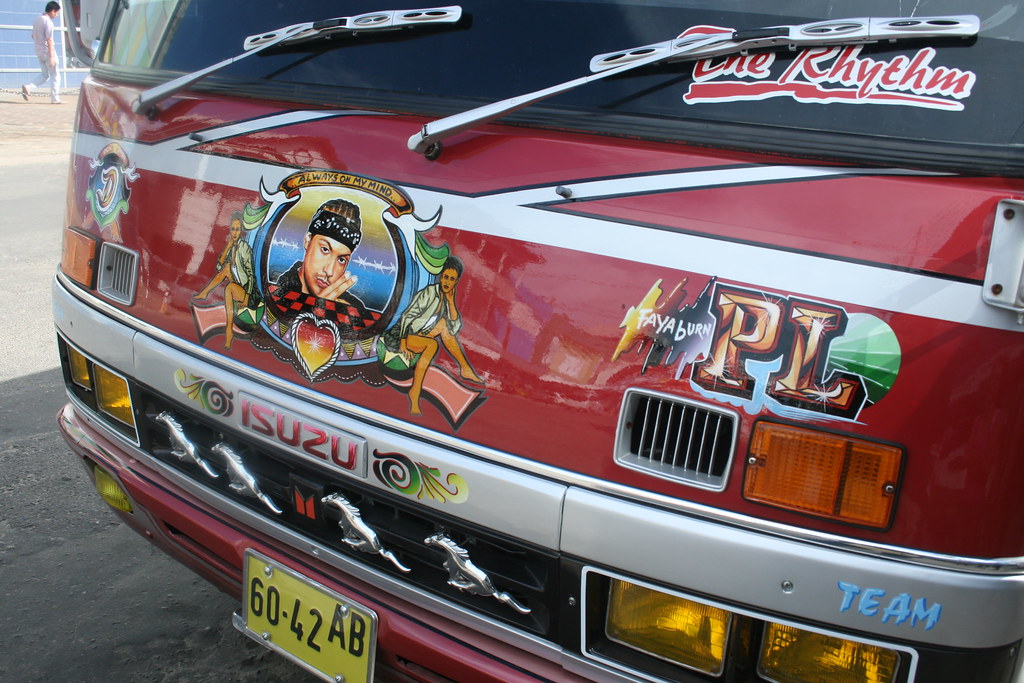
Painting of dancehall star Sean Paul on a minibus in downtown Paramaribo, June 2009. Photo by Christopher Cozier
Like many who engage the Caribbean, for me the question Where is the Caribbean? often comes up. Because of emigration and expanding diasporic communities spread across Europe and the Americas, the Caribbean is best understood as a space rather than a specific location or place. Its permeable boundary may not delineate a particular territory.
This space is constantly shifting and expanding. The Caribbean is wherever its people find themselves and wherever people imagine the Caribbean. We are all now operating within this critical space. This is a challenging moment, as we all, not just in Europe, find ourselves in danger of slipping backwards into the despair of ethnic, cultural, and national territories or enclosures, not always for self-awareness but for vicious local squabbles over diminished resources.
The Caribbean in which Paramaribo resides or to which it reaches out or is sometimes narrated can also be seen as a critical space defined by certain questions about labour camps evolving into societies, about transplanted populations and early moments of Modernity defined by transnational labour sites and trade routes, and relations between competing European kingdoms transforming into nation states. By the struggle for its subjects from being property to being citizens--from being owned to owning. The Caribbean's relationship to Brazil or to Cayenne are all being processed.
Keti Koti cloth commemorating Emancipation, in a street vendor's tent in downtown Paramaribo, June 2009. Photo by Christopher Cozier
I do not think it is useful to the artists here for the Paramaribo SPAN project to be just a themeless national/cultural or ethnic list or inventory, with passport portraits, biographies, and a single work represented by a static image--a mere generic national culture calling card. There are too many books like that, and they do little to allow critical entry to the work and ideas of the artists.
The Rotterdam participants in the ArtRoPa project may be seen as belonging to a national discourse and an implied larger European and assumed “Internationalist” pedestal of old. Within this narrative, the Surinamese artists sit apart and within a fixed national, assumed cultural boundary and distanced placement--even those currently living and working in Europe. They are trapped within an overly defined representative role--a designation. Neither can see each other. We cannot really see them.
However, in response to today’s global questions, all of these assumptions mutually impose the same restricted readings. How can Paramaribo SPAN bring all of these participating artists into a critical context that does not make restrictive displays of their “difference” for consumption? How can we create a platform that unravels their common concerns as visual practitioners? To me, this can only be accomplished by looking at the work itself and by listening to the artists to see how these concerns may give shape to curatorial purpose--allowing a meeting point between curatorial and artistic intent.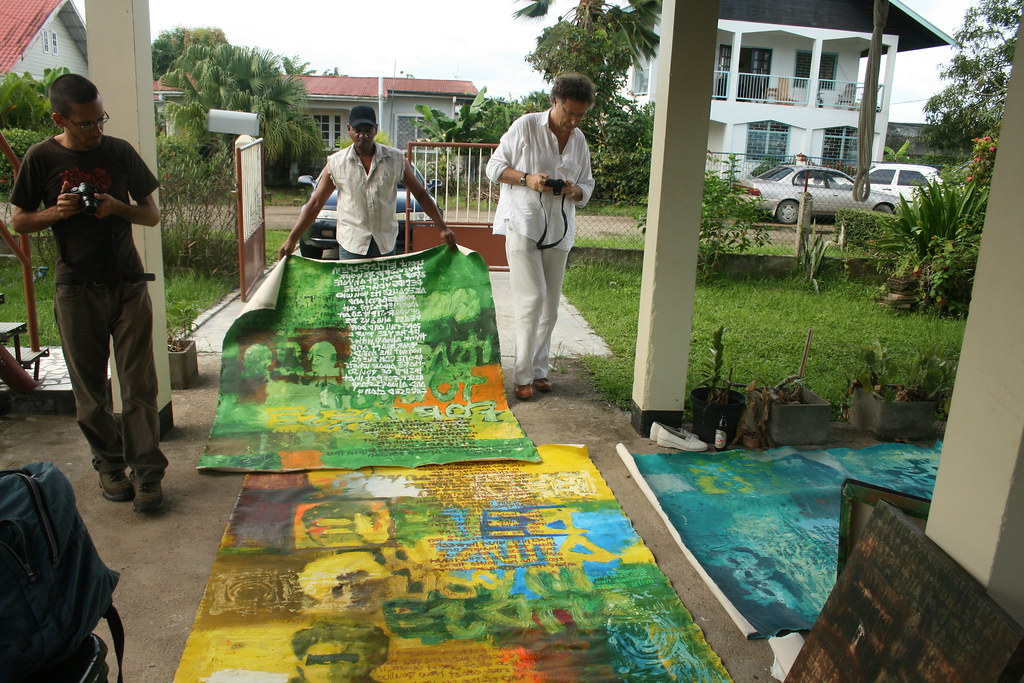
Visiting artist Ravi Rajcoomar's studio, June 2009. From left: writer Nicholas Laughlin, Rajcoomar, curator Thomas Meijer zu Schlochtern. Photo by Christopher Cozier
For me, visiting these artists is also like an out-of-body experience, as most of the time I have been on the other side, being observed. Bobbing and weaving like a featherweight boxer contending with the scrutinising gaze--contending with the conditions of visibility.
In revisiting Soeki’s studio, I was thinking of a painting I had seen in 2005. One which the artist said was inspired by the aspirations of Carifesta, and through which he confidently investigated or navigated the neo-expressionism of late Modernity, but also aligned to similar ventures in the Antilles.
At the time, I was thinking of the works of Isaiah Boodhoo, Kenwyn Crichlow, and the Parboosinghs in Jamaica, for example--artists who pursued more open gestural and less schematised surfaces. In their work, ideas about rhythm, improvisation, and how colour functions in the Caribbean are investigated, but not exclusively in perceptual pursuits. There was also a conversation/speculation around sensibility and ethnicity. It was an optimistic dialogue about cultural crossovers and integration after electoral and national politics had failed us.
Soeki Irodikromo and Christopher Cozier discussing the painting Ontmoeting, June 2009. Photo by Thomas Meijer zu Schlochtern
Instead, visiting Soeki’s studio in June 2009, I encountered another recent and casually accomplished work called Ontmoeting.
Our conversation that day drifted from his recently stolen songbird, and its spectacular trilling (or “shining”, as we say in Trinidad), to his interest in and commitment to painting. Minding these vain and fickle tropical birds is a similar extended negotiative process, with its own form and aesthetic concerns--something like painting--which has fascinated me since my childhood, and which still seems to escape my full understanding. We were finding common ground.
Looking at the worlds that artists of Soeki’s generation try to reconcile, looking back into their ongoing moment--ongoing in that their concerns remain current each time one looks at or experiences the work--asks informative questions about our current location and ways of seeing.
Read the first set of Cozier's project notes here.
Labels: bridge, caribbean, cozier, notes, ontmoeting, soeki irodikromo
Seen: Suriname, Inside-Out, by Reshma Kirpalani
Monday, August 24, 2009

Photographer Reshma Kirpalani was born in Suriname but grew up in the United States. She is currently based in Florida. In 2007 she returned to Suriname and found, as she puts it, "a country full of cultural contradictions, swelling potential, woeful corruption, spiritualism, and spooky small towns with all-time high suicide rates."
The photographic project she started then is documented both on her blog Tatata and in a carefully curated selection of black-and-white images posted in a Flickr photoset, accompanied by a brief essay.
"I discovered Suriname," she writes. "No longer the resting my place of vague, childhood memories, this country is instead sometimes charming, sometimes alarming, always home. And yet, even as I enjoy citizenship status in this country, I am not wholly accepted as a 'local.' Rather, I am pointed to as the small American with the oversized camera....
"I no longer seek to 'sum-up' Suriname. Rather, I intend to explore this country just as it exists, at this point in time: on the eve of an election year, on the brink of progress, in the ebb and flow of inevitability."
See selections from Kirpalani's Suriname images here and here.
Labels: flickr, kirpalani, photography, seen
Diary: in Ellen Ligteringen's studio
Wednesday, August 19, 2009
By Nicholas Laughlin
27 June, 2009
Ellen Ligteringen works in a small bungalow in a quiet suburban neighbourhood north of central Paramaribo. The first sign that this is not simply a respectable middle-class house is the wooden rack in the paved driveway, hung with net sacks of what look like--
"Duck feathers," she says. "It's raining so much these days, they aren't drying properly."
Yet more sacks of feathers are hung around the enclosed verandah, and despite the excellent ventilation there is a definite fowlyard whiff in the air. Next to the kitchen door is a small washing machine, which Ligteringen uses to clean the feathers when they arrive from the duck farm.
Inside, the house is set up like a cross between a factory workshop and a science laboratory, with a long worktable down the middle of what probably used to be a living room. Steel shelves on either side are packed with boxes and plastic storage crates, neatly labelled. Lengths of wood and metal wire and an assortment of tools are neatly lined up on the table, alongside bowls and baskets of botanical specimens like seed pods and twigs. In one corner of the room is a heap of small green leaves, withered but not yet dried. On the kitchen counter, sealed glass jars are filled with a nearly opaque brown liquid, and what look like pieces of--
"Chicken skin. I'm experimenting with chicken leather."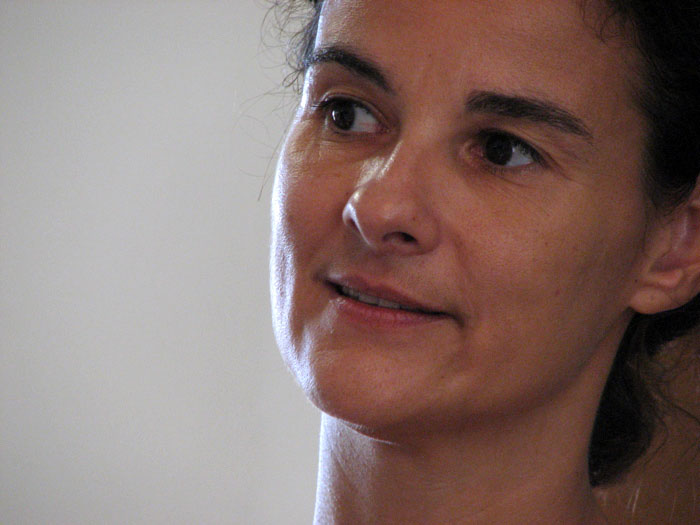
Artist Ellen Ligteringen. Photo by Nicholas Laughlin
Of all the artists we have met on this trip to Paramaribo, Ligteringen is the one working with the oddest materials, and in the most open-ended, process-driven mode. Her current projects are investigative in an almost old-fashioned way. She seems fascinated with natural materials commonly thought to have little value--hence feathers and skin that are by-products of the poultry industry, and leaves, bark, and twigs from wild plants that would normally be considered "bush" needing to be cleared away.
Born in the Netherlands, but half-Surinamese (on her mother's side), Ligteringen moved to Suriname some years back. On the one hand, her work demonstrates a strong ecological consciousness. On the other, it seems to grapple with various cultural discomforts and shocks. She shows us a strange object that for want of a better word you might call sculpture: a pouch of brown chicken leather, roughly triangular in shape, filled with uncooked rice. It looks something like a pincushion, something like a piece of offal (a stomach?). "I call it Chicken and Rice," says Ligteringen, a wry reference to Suriname's national dish, which she says she got sick of eating over and over again. It is a weirdly fascinating object, both witty and rather morbid, simultaneously attracting and repulsing tactile investigation. You don't know if you want to touch it or not. (I didn't.)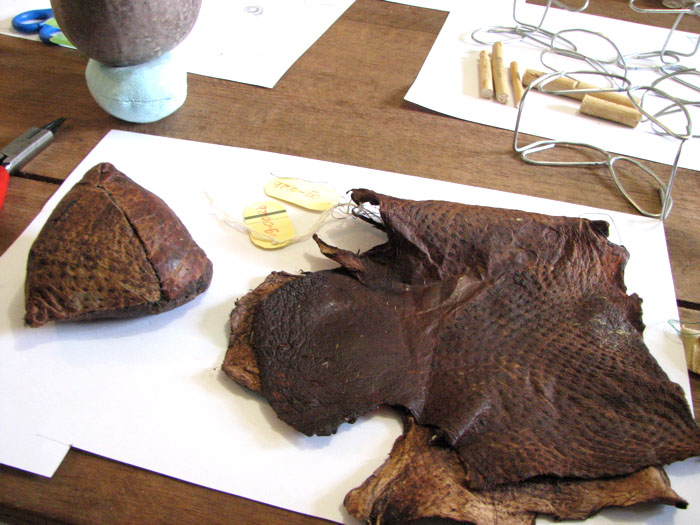
In Ellen Ligteringen's studio. The triangular object to the left is Chicken and Rice. Beside it are samples of chicken leather. Photo by Nicholas Laughlin
She tells us how she taught herself to turn chicken skin into leather, researching the tanning process and devising a formula for a sort of tannin broth made from leaves and bark. Those murky jars on the kitchen counter are the next few batches of leather in progress. When she brings us cups of tea, the hot brown liquid exactly the same colour as the stuff in the tanning jars, I take a cautious sniff before I sip.
Next she shows us another sculptural object, a large dragonfly, a foot long, made from bent wire and scraps of wood. Fragments of bone, beetle wings, snakeskin, who knows what else, wait to be incorporated into the insect sculpture. I can't help thinking of Maria Sibylla Merian, the German artist-naturalist who spent two years in Suriname at the end of the 17th century, studying insect metamorphosis and recording the natural history of the country in vivid watercolours. Merian caught butterflies and moths in her kitchen garden, reared caterpillars in her parlour, and preserved small reptiles in casks of brandy.
Ligteringen's experiments are far removed from Merian's in intention, but her zestful curiosity is perhaps not so different, and her work similarly hovers at an unresolved intersection of art, science, and domestic craft. I am utterly fascinated, but can't say I entirely understand what she's looking for, or trying to make or prove or do.
By now she's moved on, and is telling us about her attempts to manufacture small batches of chocolate--she brings us yet another dark brown jar--and the cocoa trees she's planted outside, to eventually provide her raw materials. And the Surinamese Carib dancer she's been observing, fascinated by his working process. Her plans to use those duck feathers to stuff cushions of chicken leather....
Except the neighbours don't like her using her front verandah as a feather drying-room, she says as she shows us out. They don't like the smell. And maybe--she laughs--they wonder what she's really doing with them, and with all the other strange materials she collects. This small, sharp-eyed woman with her baskets of leaves and sacks of seed pods and bits of bone--is she an artist, or is she working some other kind of magic?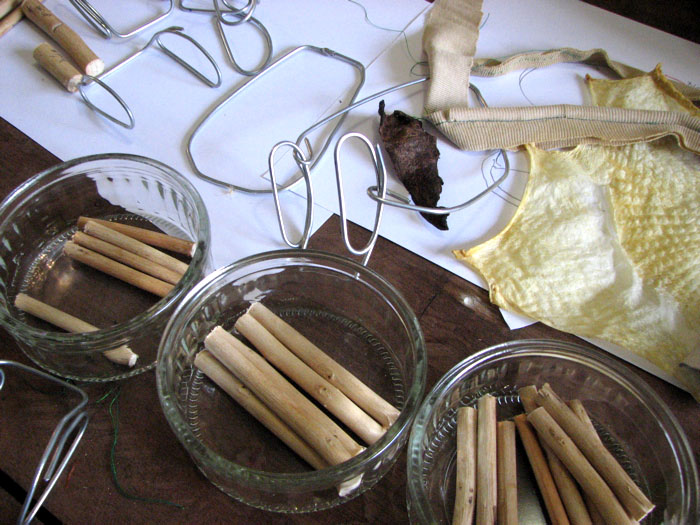
In Ellen Ligteringen's studio. Photo by Nicholas Laughlin
Labels: diary, laughlin, ligteringen, merian
Topography: Empire cinema, Fred Derbystraat
Monday, August 17, 2009
Labels: cinema, fred derbystraat, topography
Project: Arnold Schalks, Someni Tongo
Friday, August 14, 2009

Participants in Someni Tongo at the STVS studio, 22 November, 2008
Rotterdam-based Dutch artist Arnold Schalks is one of the participants in the ArtRoPa project, and the instigator of the journal De Surinoemer. In late 2008, during his artist's residency in Paramaribo, he created Someni Tongo, a community project that centres around poetry and recitation.
"Someni tongo" is a line from the poem "Wan Bon" ("One Tree") by the celebrated Surinamese poet and performer R. Dobru. Schalks interpreted "someni tongo"--"so many tongues"--as an imperative, and had Dobru's poem translated from Sranan into fifteen other languages spoken in Suriname: Arawak, Aukan, Chinese, English, Hindi, Modern Hebrew, Javanese, Kaliña, Lebanese, Dutch, Portugese, Saramaccan, Sarnami, Spanish, and Trio.
Premiere of Someni Tongo, broadcast on STVS
Schalks incorporated the sixteen translations in a five-part arrangement for a speaking choir. The translations are interwoven in such a way that each part sheds a different light on the poem's theme, "unity in diversity"/"diversity in unity". In each part, the sixteen voice-groups (one for each language) pronounce their versions of the poem simultaneously. The mixed choir, composed of 43 Surinamese, was conducted by Eldridge Zaandam and accompanied by the percussionist Ernie Wolf.
Someni Tongo was performed twice in Paramaribo: on Saturday, 22 November, 2008, at in the STVS studio, and on Saturday, 29 November 2008, in the Palmentuin. Schalks also produced a limited-edition DVD documenting the project in still and moving images.
"What I like about Dobru's poem is that it initially appears to be simple, something that must have been made with great ease. But if you look closer, you see a tremendously ingenious, sophisticated poem. I parsed it with respect, and tried to find just the proper visualisation of it. 'Someni tongo' was my starting point. Once you have so many languages, you also need people who speak those languages. And if these people finally line up, then 'someni prakseri', 'someni wiwiri', 'someni skin' but also 'wan pipel' suddenly become visible. You're looking at a sculpture. The perfect visualisation of the poem."
--Arnold Schalks, interviewed in November 2008 on the Skrifiman Taki ("Writer's Talk") radio programme, SRS-radio.
Someni Tongo performed at the Palmentuin, 29 November, 2008
For more information about Someni Tongo, including the names of the participants in the performance, see Arnold Schalks's website.
Conjunction: G-Star/WI STAR
Wednesday, August 12, 2009
By Nicholas Laughlin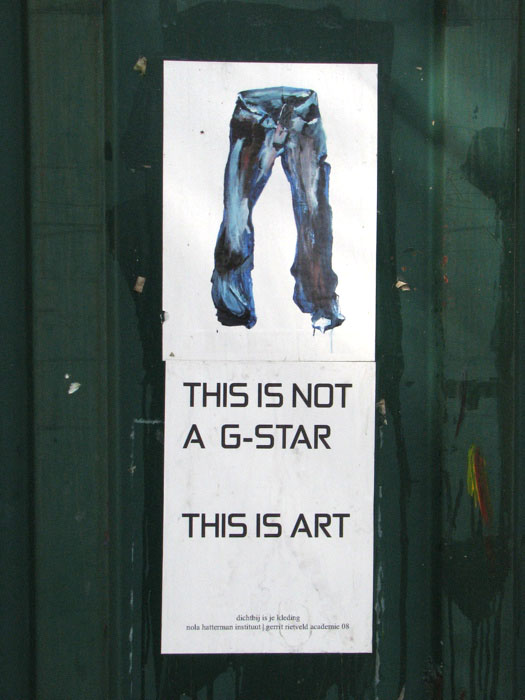
This Is Not a G-Star / This Is Art, poster project by Shaudell Horton. Photographed in Paramaribo, 12 April, 2009
The rough, rudimentary, and raw characteristics of the brand allows G-Star to maintain its distinct and unorthodox style.... Futuristic and cautious. Far-reaching and experimental. Alternative and traditional. G-Star is about making eccentric combinations, and maintaining authenticity.
-- From the G-Star website.
G-Star RAW is a Dutch clothing brand whose "urban" style, often influenced by military apparel, is popular with young people in Western Europe--and in Suriname, where their boldly branded jeans, jackets, and t-shirts are a fixture in boutique windows along Domineestraat and other major shopping thoroughfares, competing for space with North American labels like Levis and inexpensive clothing imported from Brazil.
The brand doesn't seem to have caught on yet in the Anglophone Caribbean, and I'd never heard of G-Star until I noticed the poster above, pasted on a outdoor wall, in Paramaribo last April. I would have taken it for an advertisement, were it not for the location, just outside the Nola Hatterman Art Academy. A closer look revealed a caption suggesting this was an artist's project, but no name. Later I found out the poster was the work of Shaudell Horton, a student at Nola Hatterman, who made the piece during a 2008 workshop with a visiting instructor from the Gerrit Rietveld Academy in Amsterdam.
Visiting Paramaribo again in June, I thought of this poster one mid-morning when I ducked into a trendy downtown clothing shop to escape a sudden downpour. The women's section downstairs was packed with smartly dressed teenage shoppers. Upstairs was less hectic. As I browsed the racks, waiting for the rain to stop, I noticed a display of t-shirts with a distinctive graphic style. In varying combinations of red, green, yellow, black, and white--Suriname's national colours--they were boldly branded "WI STAR", in blocky text with the star-in-a-circle icon from the national flag.
Label on a WI STAR t-shirt, bought in Paramaribo in June 2009
Like Horton's poster, these t-shirts cheekily--and stylishly--comment not only on the shopping preferences of young Surinamese, but also on the notion of clothing and fashion as a badge of social identity--individual, communal, national, transnational. WI STAR means, of course, "our star" (perhaps with a hint of "we are stars"?), but to my Antillean eyes "WI" also suggests "West Indies", and the t-shirts are one more piece of evidence, conscious or otherwise, of Suriname's links to the Caribbean.
Needless to say, I bought one.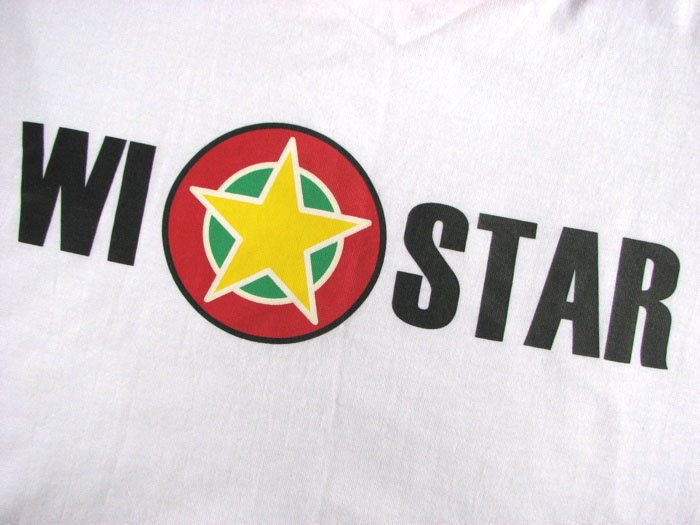
Graphic on a WI STAR t-shirt, bought in Paramaribo in June 2009
Labels: conjunction, fashion, g-star, laughlin, poster, shaundell horton, t-shirt, WI STAR


